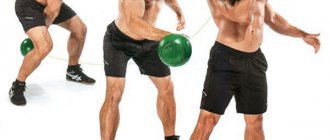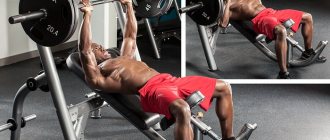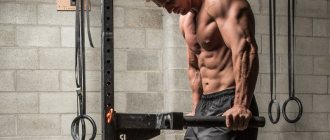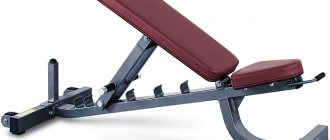You can pump up your breasts in different ways. One of the most effective is to do dips. Find out more about it!
You can pump up your breasts in different ways. One of the most effective is to do dips. However, it is not enough to just do this exercise; you need to adhere to the correct technique. Only then will you be able to pump up your chest on the uneven bars and achieve impressive results in the shortest possible time. Otherwise it will take a lot more training. And it is far from a fact that their quantity will compensate for the quality and lead to the desired effect.
Push-up technique
Rest your palms on the bars, hold your torso on straight arms. Don't start from the bottom, it's risky.
Lean forward. Bend your elbows and slowly lower yourself down. Avoid sudden movements, otherwise you may injure your chest muscles. For the same reason, prevent the inertial lowering of the body.
Take a two-second pause, during which you make sure you are in the right position. Since the exercise is aimed at working the pectoral muscles, the elbows should be directed to the sides, the hands should be directed towards the body. In this position, the lower and middle sections of the chest are involved. It is also important to maintain a forward lean.
Return to the starting position. Do not press your elbows to your body. For the first few workouts, keep it fluid while you perfect your technique. Later you can perform this part of the exercise at a faster pace.
Repeat as many times as necessary.
You are in the section:
Sports and beauty > Exercises for training > Dips for pumping chest muscles
Hi all! Today we will look at the parallel bar push-up exercise to pump up the chest muscles , look at the technique and the main mistakes.
Depending on the technique you perform on the uneven bars, you can perfectly pump up your chest and triceps muscles. I think we will look at working with an emphasis on triceps in another article, and today we will fully analyze dips on the uneven bars for the development of a powerful and massive chest.
This is an excellent exercise, a basic exercise for building muscle mass in the chest, but at the same time it is one of the most traumatic, and therefore, before you start performing it, you need to sort out the main mistakes and hone the technique from the very first days.
In this exercise, the main part of the load is received by the lower and middle part of the pectoral muscles, the deltoids and triceps are also included. But in order for the chest muscles to still receive the maximum load and not allow the triceps to steal the load, you need to adhere to the following rules.
Rules for dips on the chest muscles
- From the anatomy course, we know that the main function of the pectoral muscles is to bring the arms to the body, bring them together and rotate them inward. In other words, in order to maximally pump the target muscles, we must spread our elbows to the sides; for this, choose bars with wide handles. By moving the elbows away from the body, we create conditions under which bringing them back was prevented by the force of resistance, in our case this is our own weight;
- Depending on the angle between the torso and arms, we can accentuate the load on the desired part of the pectoral muscles. That is, the more you tilt your body forward, the better the middle part of the pectoral muscles is involved in the work. If the body is slightly tilted forward, then the lower parts of the chest receive most of the load;
- As noted above, choose bars with wide handles (slightly wider than your shoulders); if the handles are narrow, then you will physically not be able to perform the correct movement and reach the chest muscles, and the main load will go to the triceps;
- You should not fully straighten your arms at the top point, so as not to remove the load from the pectoral muscles and not to shift the emphasis to the triceps;
- In order to focus the load on the chest muscles, your gaze should be directed downward, thereby making it easier to keep your back rounded.
Bodymaster.ru recommends Training Plans:
The effectiveness of the exercise will be much higher if the following conditions are met.
The distance between the bars should be slightly wider than shoulder width. If it exceeds it significantly, you risk injuring your shoulders, and if it is insufficient, you will not be able to exercise.
First, get used to your weight, and only when you learn to work with it confidently, resort to additional weights.
When partially lowered, the load on the pectoral muscles is reduced. Therefore, to pump up your chest on the uneven bars, complete the exercise and sag as deeply as possible. Ideally, your hands should be at armpit level. If this does not happen, then there are deficiencies.
Technique for performing chest push-ups
Dips to pump up the pectoral muscles are easy to do, but you should understand that you won’t be able to completely “turn off” the triceps. The shoulders or deltoids will also be constantly involved.
How to pump up your pectoral muscles in a short period of time? First of all, you need to choose the right parallel bars; the position of your hands when performing exercises should be slightly wider than your shoulders, approximately the same as when doing push-ups from the floor. A wide grip will ensure the correct execution of all exercises, but if your hands are too wide, the risk of injury to the shoulder joints immediately increases. Narrow bars will not allow you to perform the complex correctly, the benefit will be minimal.
Exercises for the pectoral muscles on the uneven bars are performed as follows:
- starting position at the top point with straightened arms and straight back;
- legs are bent at the knees and crossed;
- when inhaling, you need to slowly lower yourself down until you feel a good stretch in the muscles;
- as you exhale, rise up, while straining all the pectoral muscles as much as possible;
- the exercise is repeated the required number of times.
Recovery
Every experienced athlete knows how important the recovery process plays in the process of growing muscle mass and achieving high results. If we talk about training on the uneven bars, experts recommend doing it no more often than every other day.
In order to thoroughly pump the muscles of the chest area, during the recovery period you should provide the body with a sufficient complex of nutrients and microelements useful for the development of muscle mass, while not forgetting about complete relaxation. By following all the above tips, you can get a really well-developed and attractive torso, beautiful pumped up arms, and clearly visible abdominal muscles without any extra work and grueling training.
Results
In conclusion, it is worth highlighting a number of rules that the athlete must take into account:
- After strengthening the muscles and achieving maximum amplitude, you should move on to working with weights. Thanks to the additional weight, it is possible to reduce repetitions to 8-10 and accelerate muscle growth. The main thing is to be careful when lifting your body to the top position. Sharpness in performing exercises with weights is possible only after several months of training.
- When working, try to lower slowly (in 2-3 counts) and rise quickly.
- Slow lowering ensures chest stretching and microtrauma of muscle fibers, which subsequently promotes muscle growth.
Partial range push-ups
When you have some strength left after completing the main program, there is a way to increase your dips.
To do this, with the last of his strength, the athlete performs a partial lowering of the body, approximately 30-50 degrees down.
Mostly small muscles work, which will take on additional load in the next workout, allowing you to do more repetitions.
How can you improve your training?
Each exercise has its own nuances of implementation.
Bars help make the pectoral muscles larger, more aesthetically pleasing and stronger, even more than a barbell in the gym.
Professional athletes provide the following observations that they have made from their training:
Weighted dips allow you to accelerate weight gain when the athlete has reached his peak.
For beginners, it is advisable to perform triceps-oriented techniques. This is due to the fact that their entire chest cannot be involved in the work, since the triceps do not perform a stabilizing function efficiently.
The main thing is speed of execution. Quick shudders will not lead to anything good.
So focus on inhaling slowly, as your body slowly lowers, and exhaling more quickly. But you need to maintain smooth movements all the time.
Weight training
Only parallel bars can completely replace the chest press.
What such exercises do has already been described above. In order for parallel bars training to become a basic exercise for working the core muscles, you should work with some weights. You can secure the loads on a special belt to the lower back, each time using more and more significant weight. Before you begin weight training, you should work hard to perfect the technique of performing the necessary exercises. It is also extremely important to select the most comfortable grip.
The main points when pumping up the chest on the uneven bars
Warm-up and stretchingThe first step is always the warm-up approach.
And this is correct when your weight is not too high. Guys over 90 kg can easily damage their deltoids. Therefore, they need to warm up with push-ups on a bench. You need to perform 10-15 push-ups, starting at low speed and ending at a fast pace. Before pumping your chest, you need to stretch. To do this, grab the parallel bars as if you were about to do an exercise. In this case, you slightly rest your feet on the floor or ground so as not to injure the ligaments with the weight of your body. From this position we go down as far as possible and at this point we do several oscillatory movements. The sensation should be on the verge of pain, but not acute, but barely noticeable.
If your weight is light, warm up by doing 10-12 dips on the parallel bars, or more if your physical fitness allows you without compromising your main workout.
Before training, be sure to warm up well. The minimum is intense rotational movements of the arms in the shoulders, elbows and hands. The maximum is a five-minute jog in the fresh air, and then local warming up of the joints.
Weights To build up muscles on the uneven bars, you need a progressive load. You can exercise in the gym, on the street, and at home. There is a special belt in the hall on which you can hang pancakes. At home and on the street, a backpack with dumbbell plates neatly placed in it will suit you.
If you don't have dumbbells, plastic bottles from various drinks will do. Fill them with water - this way you can gain 10-15 kg of weight. Someone is putting weights in a backpack. We recommend using pancakes: they take up little space, and it is possible to conveniently dose the load by changing the number of pancakes in the backpack.
The only problem is how to carry this load to the training site. It's good if you're at home. We recommend purchasing a weight belt. So be prepared to carry the weight all the way to the site.
It is advisable that the backpack have additional fastening straps - then it will not painfully slap you on the back while walking and doing push-ups.
At first, a weight of 10–15 kg will be enough for you. Then the body will want more. With constant training you can reach up to 60 kg. Remember that it is convenient to carry no more than 20 kg with you. Heavier weights can cause damage to your pack and back.
Don’t experiment with how much weight you can do one push-up. This is dangerous for your collarbones. Let's pump up our strength, not test it just once.
Position of the parallel bars and arms Don't forget that the parallel bars also work your shoulders and triceps. To pump up your chest as much as possible, you need to:
- Lean forward slightly and slouch, contracting your pectoral muscle. The back becomes round.
- You can do “diving” movements and arch in a “boat” manner, then the middle part of the chest will work.
- With a more even execution, the lower chest works.
- We place our elbows to the sides, or move the bars further away from each other. Then the load will go to the pectoral muscles.
The further apart your elbows are, the less your arms work.
Accordingly, the more the pectoral muscle is loaded. This is what we need. Number of workouts per week, approaches, repetitions To pump up muscles, you will need to reach 4 sets of 6-8 repetitions with weights. And in the beginning, if you have not done push-ups before, you need to regularly perform this exercise 2-3 sets of 10-15 times. Each time we try to increase the number of repetitions.
For those who cannot do 10 repetitions in one approach, you need to work to the maximum. Do the first set as much as you can. Until failure. It's okay if you can't finish your last rep. Rest.
Do the second set to the max. Then the third. It is permissible to pump the pectoral muscle in this way 2 times a week with a break of 2-3 days.
Example: a person does push-ups on parallel bars without weights 20–25 times, depending on how he feels. He does the first approach 22 times, the second - 17, the third - 11. This is normal - the muscles get tired.
Rest between sets and workouts Forget all the standard 1-1.5 minutes of rest between sets. In addition, this is most likely recommended by people actively taking pharmacological drugs. Their body recovers much faster, and they can easily complete the entire training plan with such a temporary regime and quickly pump up their body.
When you're working on strength and mass, you need to rest as much as your body requires. But no more than 5 minutes. Typically, athletes need 2-3 minutes between approaches.
While you are resting, there is no need to stand still. Walk back and forth, wave your arms, breathe deeply. It's important to rest, not cool down.
When you rest between workouts, be mindful of proper recovery. Without it, you won't be able to pump anything.
General provisions
Despite its apparent simplicity, dips on parallel bars require knowledge of the rules and strict adherence to them. The following points are worth highlighting here:
- Place your wrists vertically and keep them level with the elbow joint. A normal grip is considered to be when the hands are slightly wider than the shoulders.
- Keep your elbows close to your body throughout the exercise. In the top position, they should be straightened completely only if you are focusing on the triceps. If you have sufficient flexibility, you should lower yourself to the limit of your joints.
- The shoulders should not move during the approach (no oscillatory movements). Otherwise, the risk of injury increases and efficiency decreases.
- Watch your spine - straighten it into a “string”. Thanks to this body position, the effectiveness of exercise increases.
- Try to tense your core (abs) muscles. The corset should be tight throughout the entire exercise. Thanks to this, it is possible to stabilize and hold the back in one position.
- It is forbidden to spread your legs (they must be pressed together or crossed). Tighten your hips and gluteal muscles, pull your toes back.
- Pay attention to your breathing. Air is released during ascent and gained as the body descends .











